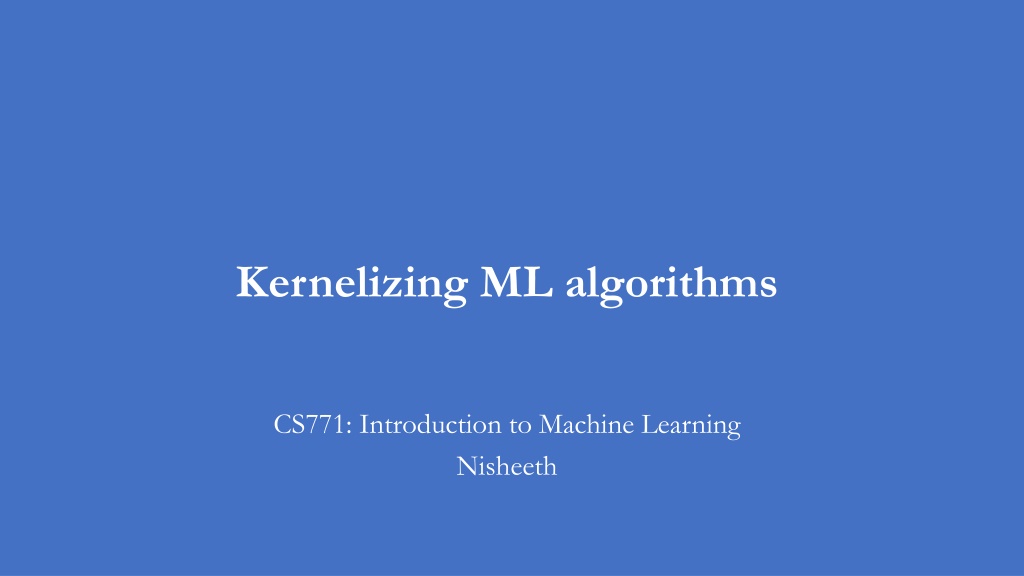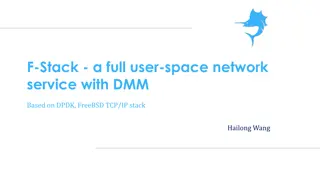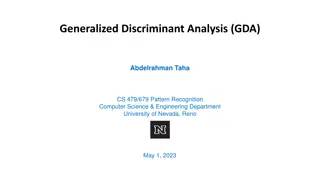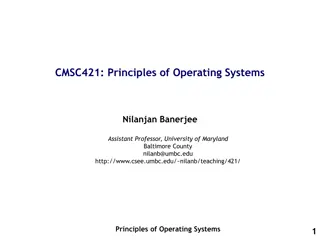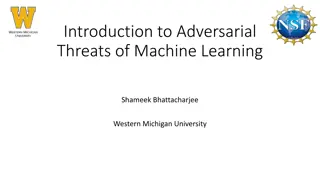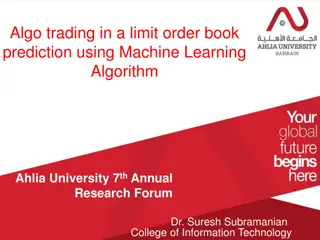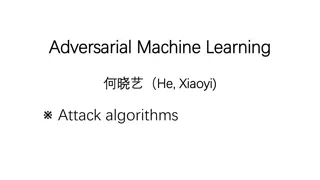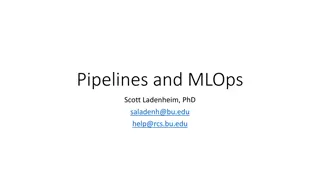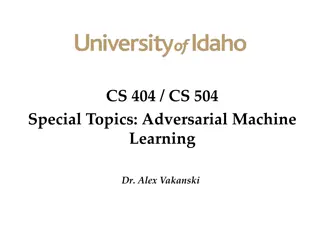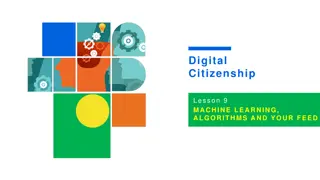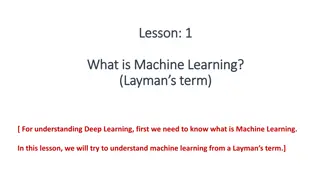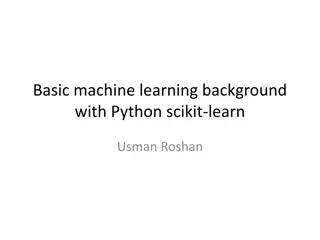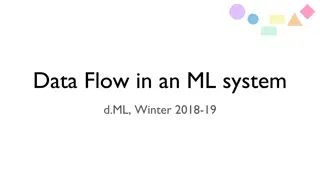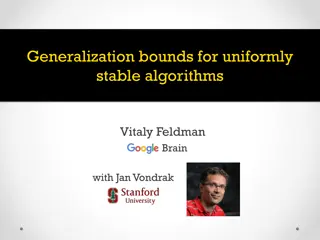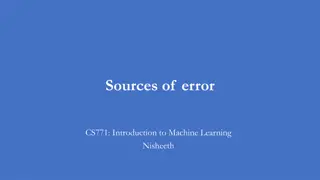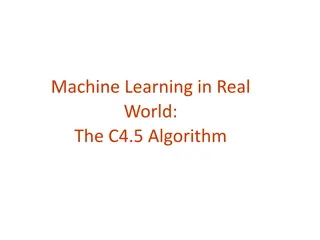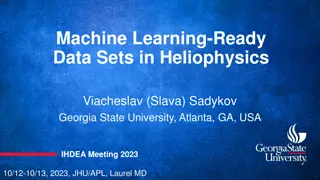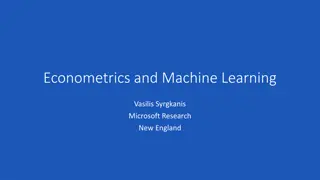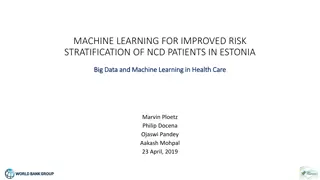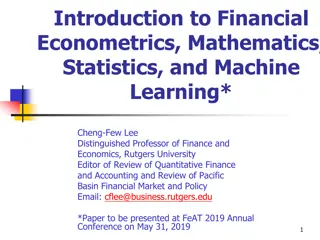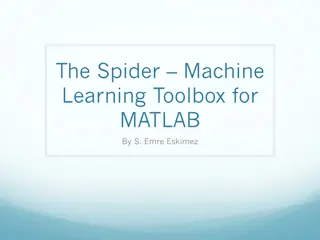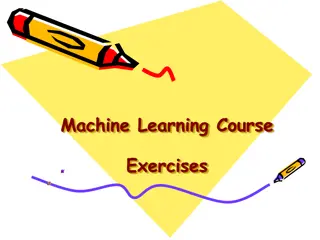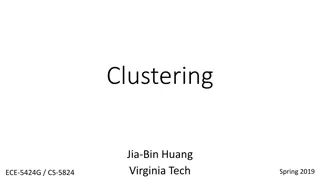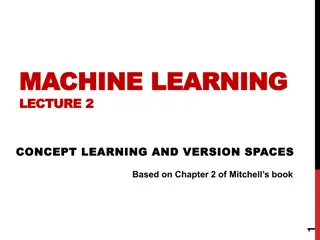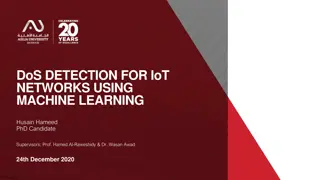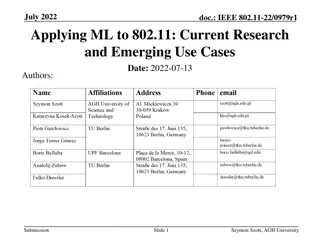Understanding Kernel Tricks in Machine Learning
Kernel tricks in machine learning involve transforming inputs into higher-dimensional spaces to make linear models work for nonlinear data. Kernels can be applied to various algorithms like SVM, ridge regression, and more, allowing for better model performance with complex datasets.
Download Presentation

Please find below an Image/Link to download the presentation.
The content on the website is provided AS IS for your information and personal use only. It may not be sold, licensed, or shared on other websites without obtaining consent from the author. Download presentation by click this link. If you encounter any issues during the download, it is possible that the publisher has removed the file from their server.
E N D
Presentation Transcript
Kernelizing ML algorithms CS771: Introduction to Machine Learning Nisheeth
2 Recap: Kernel functions Can assume a feature mapping ?that maps/transforms the inputs to a nice space The linear model in the new feature space corresponds to a nonlinear model in the original feature space .. and then happily apply a linear model in the new space! CS771: Intro to ML
3 Using Kernels Kernels can turn many linear models into nonlinear models Recall that?(?,?) represents a dot product in some high-dim feature space Important: Important: Any ML model/algo in which, during training and test, inputs only appear as dot product can be kernelized ?? by ? ?? ? ?? = ? ??,?? = ??? Just replace each term of the form ?? Most ML models/algos can be easily kernelized, e.g., Distance based methods, Perceptron, SVM, linear regression, etc. Many of the unsupervised learning algorithms too can be kernelized (e.g., K-means clustering, Principal Component Analysis, etc. - will see later) Let s look at two examples: Kernelized SVM and Kernelized Ridge Regression CS771: Intro to ML
4 Nonlinear SVM using Kernels CS771: Intro to ML
5 Solving Soft-Margin SVM Recall the soft-margin SVM optimization problem Here ? = ?1,?2, ,??is the vector of slack variables Introduce Lagrange multipliers ??,?? for each constraint and solve Lagrangian The terms in red color above were not present in the hard-margin SVM Two set of dual variables ? = [?1,?2, ,??] and ? = [?1,?2, ,??] Will eliminate the primal var ?, b b, ? to get dual problem containing the dual variables CS771: Intro to ML
6 Solving Soft-Margin SVM Note: if we ignore the bias term ?then we don t need to handle the constraint ?=1 (problem becomes a bit more easy to solve) ? ????= 0 The Lagrangian problem to solve Otherwise, the ?? s are coupled and some opt. techniques such as co-ordinate aspect can t easily applied Take (partial) derivatives of w.r.t. ?,?, and ?? and setting to zero gives Weighted sum of training inputs Using ? ?? ??= 0 and ?? 0, we have ?? ? (for hard-margin, ?? 0) Substituting these in the Lagrangian gives the Dual problem Given ?, ? and ? can be found just like the hard-margin SVM case The dual variables ?don t appear in the dual problem! Maximizing a concave function (or minimizing a convex function) s.t. ? ? and ?=1 Many methods to solve it. In the solution, ? will still be sparse just like the hard-margin SVM case. Nonzero?? correspond to the support vectors ? ????= 0 . . CS771: Intro to ML (Note: For various SVM solvers, can see Support Vector Machine Solvers by Bottou and Lin)
7 Kernelized SVM Training Recall the soft-margin linear SVM objective (with no bias term) argmax ? ? ? 1 2? ?? ? ? ?? ???= ?????? ?? by ??????? To kernelize, we can simply replace ???= ?????? .. where ???= ? ??,?? = ? ?? ? ?? for a suitable kernel function ? The problem can now be solved just like the linear SVM case The new SVM learns a linear separator in kernel-induced feature space This corresponds to a non-linear separator in the original feature space ? CS771: Intro to ML
8 Kernelized SVM Prediction ? SVM weight vector for the kernelized case will be ? = ?=1 ?????(??) Note: We can t store ? unless the feature mapping ?(??) is finite dimensional In practice, we store the ?_? s and the training data for test time (just like KNN) In fact, need to store only training examples for which ?? is nonzero (i.e., the support vectors) Prediction for a new test input ? (assuming hyperplane s bias ? = 0) will be ? ? ? = sign(? ?(? )) = sign ?????(??) ?(? ) = sign ?????(??,? ) ?=1 ?=1 Note that the prediction cost also scales linearly with ? (unlike a linear model where we only need to compute ? ? , whose cost only depends on ?, not ?) Also note that, for unkernelized (i.e., linear) SVM, ? = ?=1 and stored as a ? 1 vector and we can compute ? ? in ?(?) time ?????? can be computed ? CS771: Intro to ML
9 Nonlinear Ridge Regression using Kernels CS771: Intro to ML
10 Kernelized Ridge Regression Recall the ridge regression problem: Inputs don t appear to be as inner product. No hope of kernelization? The solution to this problem was They do; with a bit of algebra Can use matrix inversion lemma Using the lemma, can rewrite ? as Note: Not sparse unlike SVM ? 1 vector of dual variables where Prediction cost is also linear in ? (like KNN) ? Kernelized weight vector will be ? = ?=1 ???(??) ? ? Prediction for a test input ? will be ? ?(? ) = ???(??) ?(? ) = ???(??,? ) ?=1 ?=1 CS771: Intro to ML
11 Speeding-up Kernel Methods CS771: Intro to ML
12 Speeding-up Kernel Methods Kernel methods, unlike linear models are slow at training and test time Would be nice if we could easily compute mapping ?(?) associated with kernel ? Then we could apply linear models directly on ?(?) without having to kernelize But this is in general not possible since ?(?) is very high/infinite dimensional An alternative: Get a good set of low-dim features ? ? ? using the kernel ? If ? ? is a good approximation to ?(?) then we can use ?(?) in a linear model ? ?? ? ?? ? ?? Goodness Criterion: ? ?? which also means ? ?? Will look at two popular approaches: Landmarks and Random Features ? ?? ?(??,??) CS771: Intro to ML
13 Extracting Features using Kernels: Landmarks Suppose we choose a small set of ? landmark inputs ?1,?2, ,??in the training data Landmarks need not be actual inputs; can even be ? learned locations in the input space 3 ? ?? = ? ?1,??,? ?2,??,? ?3,?? For each input ??, using a kernel ?, define an ?-dimensional feature vector as follows ? ?? = ? ?1,??,? ?2,??, ,? ??,?? ? Can now apply a linear model on ? representation (?-dimensional now) of the inputs This will be fast both at training as well as test time if ? is small No need to kernelize the linear model while still reaping the benefits of kernels CS771: Intro to ML
14 Extracting Features using Kernels: Random Features Many kernel functions* can be written as .. where ??(.) is a function with params ? ? with ? drawn from some distr. ?(?) Example: For the RBF kernel, ??(.) is cosine func. and ?(?) is zero mean Gaussian Given ?1,?2, ,??from ?(?), using Monte-Carlo approx. of above expectation .. where is an ?-dim vector Can apply a linear model on this ?-dim rep. of the inputs (no need to kernelize) CS771: Intro to ML *Random Features for Large-Scale Kernel Machines (Recht & Rahimi, NIPS 2007. Remember the ML alchemy talk? That was these guys)
15 Learning with Kernels: Some Aspects Storage/computational efficiency can be a bottleneck when using kernels During training, need to compute and store the ? ? kernel matrix K K in memory Need to store training data (or at least support vectors in case of SVMs) at test time Test time can be slow: ?(?) cost to compute a quantity like ?=1 Approaches like landmark and random features can be used to speed up Choice of the right kernel is also very important Some kernels (e.g., RBF) work well for many problems but hyperparameters of the kernel function may need to be tuned via cross-validation Quite a bit of research on learning the right kernel from data Learning a combination of multiple kernels (Multiple Kernel Learning) Bayesian kernel methods (e.g., Gaussian Processes) can learn the kernel hyperparameters from data(thus can be seen as learning the kernel) Deep Learning can also be seen as learning the kernel from data (more on this later) ? ???(??,? ) CS771: Intro to ML
